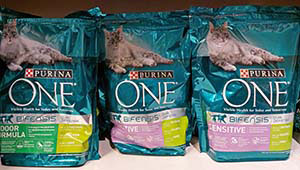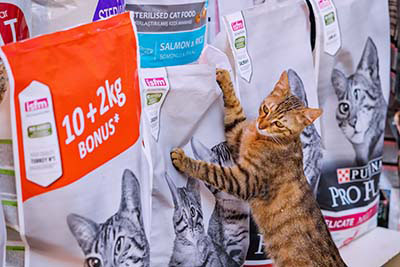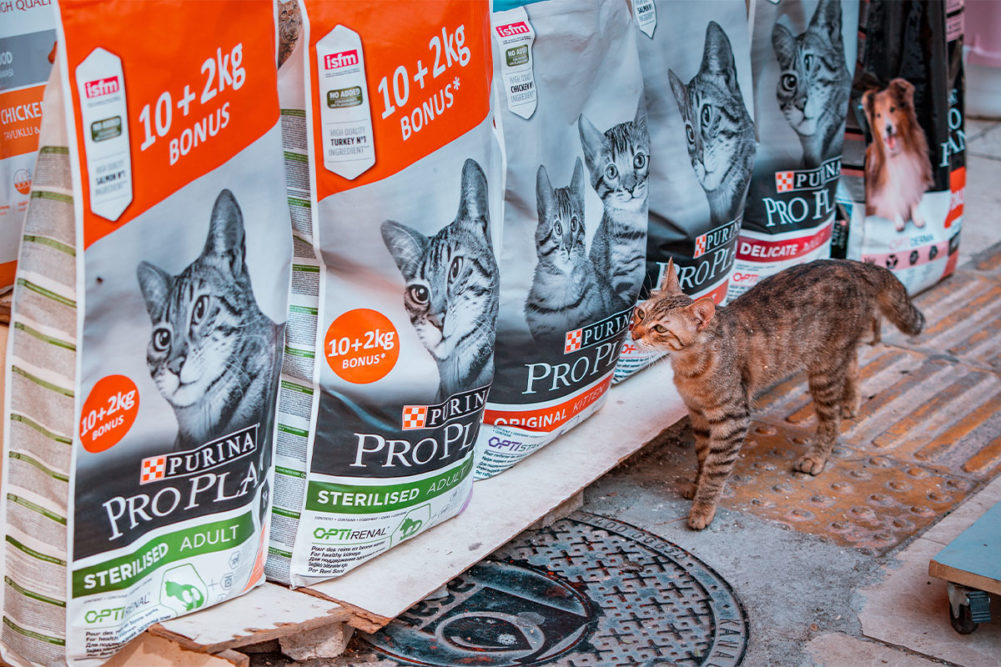BOCA RATON, FLA. — On Feb. 24, Nestlé shared its plans to further growth for its Purina Petcare division during its presentation at the Consumer Analyst Group of New York (CAGNY) Conference. The company detailed that many of its pet food brands will achieve $2 billion in sales by the end of this year, and the business will move forward with an increased focus on new market and product segments.
In 2022, Nestlé’s global sales hit 94.4 billion CHF ($100.7 billion USD), with its pet care segment accounting for 19%. According to Chief Financial Officer François-Xavier Roger, the company has invested about 1.7 billion CHF ($1.8 billion USD) in its R&D to further growth.
“We are the largest spender, in terms of R&D, in our industry,” Roger said. “This is really a good illustration of the fact that we really want to make a difference through technology and science.”
Note: Swiss franc to USD conversions are based on Feb. 27 conversion rates.
Regarding its Purina Petcare business, global sales hit 18.1 billion CHF ($19.3 billion USD) in 2022. North America and Europe remain Purina’s largest segments, accounting for 60% and 26% of its business, respectively. The company’s portfolio includes 30% dry dog food, 32% wet cat food, 19% dry cat food, 4% wet dog food and 15% other pet nutrition products, which includes pet snacks, supplements and litter.
Based on Purina’s 2022 sales, Purina Pro Plan, Purina ONE, Friskies, Fancy Feast, Felix and Dog Chow, have all achieved billion-dollar status, with Pro Plan achieving the highest sales at 2.8 billion CHF (nearly $3 billion USD). In fact, these four brands will all achieve $2 billion in sales in North America by the end of 2023, according to the company.
According to data by Euromonitor, Purina has a leading position in the global pet care market, accounting for a 20.6% share, just behind Mars at 21.9%.
“Our largest country is actually the United States, which accounts for almost one-third of our total sales worldwide,” Roger shared.
Though the United States and North America remain Purina’s focus, the company is exploring additional opportunities in emerging markets, including China and the AOA region, to further growth.
“We are especially interested, for example, in China, where we see a large opportunity with more and more younger people having small dogs or cats in their apartment, and they're very digital savvy as well, which can help us a lot,” Roger explained.
According to Euromonitor, the global pet population is expected to have a CAGR of 2.4% from 2022 to 2025, and growth for e-commerce pet care sales was projected at a CAGR of 31% from 2017 to 2021. With this in mind, the company revealed several projects to meet increasing demand.
 Source: ©ALEXBUESS - STOCK.ADOBE.COM
Source: ©ALEXBUESS - STOCK.ADOBE.COMPurina will invest approximately 3 billion CHF ($3.2 billion USD) in pet nutrition from 2022 to 2025. These projects include two dry facilities in Eden, NC., and Williamsburg Township, Ohio; two wet facilities in Wroclaw, Poland, and Rayong, Thailand; and two dry/wet combination facilities in Vargeão, Brazil, and Tianjin, China.
“We have difficulties to meet the demand today, which is a reason why we have really ramped up the amount of CapEx that we are putting through,” Roger said. “…Between 2022 and 2025, we are investing CHF 3 billion all over the world. You have units there in Thailand, in China, in Brazil, and very large investments as well in the United States.
“We are not concerned at all of the fact that we would have overcapacity… as far as we are concerned, the demand is there,” he added. “We could not even meet the demand to the point where we had to limit our marketing spend last year, so we are absolutely confident on the fact that we do need that capacity.”
Nina Leigh Krueger, president and chief executive officer of Purina North America, shared the three key growth drivers for the company: premiumization, expandable consumables, and emerging growth areas like supplements and fresh diets.
“Consumers are more cognizant of the nutrition and science that they're putting into their bodies and that's translating exactly into the pet foods that they're feeding,” Krueger explained. “We've seen a large increase in science-based nutrition brands.
“When you think about expandable consumption, consumers home with COVID are sitting with their dogs and cats on a daily basis and then feed an extra treat or two on a day or an extra can of wet cat food during the week,” she added. “And so we saw expandable consumption grow as well. Other areas of growth were in the emerging growth areas of fresh and supplements.”
For the overall pet care segment, e-commerce witnessed double-digit category growth in 2022, accounting for 20% of total sales. In 2022, dry dog food accounted for about two-thirds (37%) of the entire pet care category, wet dog food accounted for 10%, dog treats accounted for 14%, wet cat food accounted for 13%, dry cat food accounted for 12%, and cat treats accounted for 3%, according to NielsenIQ, 1010data and IDEXX Vet Clinics. The entire frozen and refrigerated sub-category accounted for just 2% of the entire pet care segment.
With this data in mind, Purina is currently operating as the No. 1 in total global pet care, according to Krueger, owning 29% of the market share and serving as No. 1 in dry dog food, dry cat food and wet cat food products. The company’s sales growth has increased from 3% in 2018 to 15% in 2022.
“We expect the pet care category to continue to deliver strong growth,” Kruger said. “This year we expect it to be double digits again as we cycle over pricing, but then we expect it to go to more historical norms around that 6% to 8% CAGR. We also expect by the end of 2025 for it to be over $57 billion here in the United States.”
To achieve this growth and maintain its foothold in the space, Krugeer shared that the company will focus on three areas to drive growth—quality and safety, digital transformation, and capital expenditure investments to feed capacity.
“Digital transformation is also important as we look to improve our operations, whether it's automation through forecasting, procurement or warehousing systems, technology is critical for us to maximize our efficiencies throughout our supply chain,” she detailed. “An example of this is we were looking to decrease system failure, so we did a trial with machine learning in our Clinton, Iowa, factory. We achieved almost 90% system failure improvement. We've now started cascading that across our dry factories and we are at almost 70% to date.
“By the end of 2025, Nestlé will have invested almost $2 billion in Purina in North America, and we will have contributed 850 jobs,” Krueger added.
Four main consumer trends are impacting Purina’s presence in the pet care market — human food ideologies, proactive health management, increased social responsibility and an “elevated” mealtime experience. To meet these trends, Purina plans to extend its leading position through product innovation and premiumization, strengthen its omni-channel presence, and create shared value through societal contributions.
 Source: ©EDNURG - STOCK.ADOBE.COM
Source: ©EDNURG - STOCK.ADOBE.COMRegarding product innovation, Krueger detailed the company would focus on its science- and solution-based formulas, explore supplemental products to offer an enhanced feeding experience, and increase its presence in the supplement and fresh segments.
“We’re going to continue to drive those science-based solutions,” she said. “Purina One, which is the largest nutrition brand in the category, knows that gut health is extremely important to their pet parents. So, they're introducing new Microbiome Balance across their portfolio. Pro Plan, which is our flagship brand and is all about introducing life-changing nutrition, is going to continue doing that by introducing Calm and Balance, which can prompt a calm behavior in as little as 12 weeks.
“We also know we need to increase our presence in emerging areas,” Krueger added. “Fresh is a topic, it’s a trend that's out there; we have multiple irons in the fire and are looking at investigating the best way to enter that category. And supplements is one of the fastest growing segments we have at Purina and we're going to continue to innovate in that area with the launch of Joint Care this year.”
As well as new formulations and products, Purina will also focus on digitally enabled sales, which is made up of e-commerce retailers and stored-based retailers that offer e-commerce purchasing methods. The company’s digitally enabled sales more than tripled from $9 million in 2018 to $3.1 billion in 2022, making it the No. 1 in market share within the digitally enabled sector.
“When you take a look at digitally enabled sales, I mentioned that e-commerce pure-play represents 20%; when you add in store-based, digitally enabled sales hit 25%,” Krueger said. “We expect that to be 30% by 2025. Purina several years ago invested in this area with resources and people and capabilities. We also started partnering with retailers so that we could offer that omni-channel shopper their products whenever, wherever and however they wanted to shop.”
To foster consumer loyalty, Purina will also add new business models, including the myPurina app, offering a host of additional value to consumers.
“I'm very excited about this because this is going to be the one stop shop for consumers,” Krueger said. “When they want that frictionless experience, where they need expertise, so they want to interact with the brands, the Purina brands that we know and love, this is a place where they're going to be able to do it. We're going to add value to the consumer and we're going to increase loyalty to Purina.”
Read more news from pet food manufacturers.





